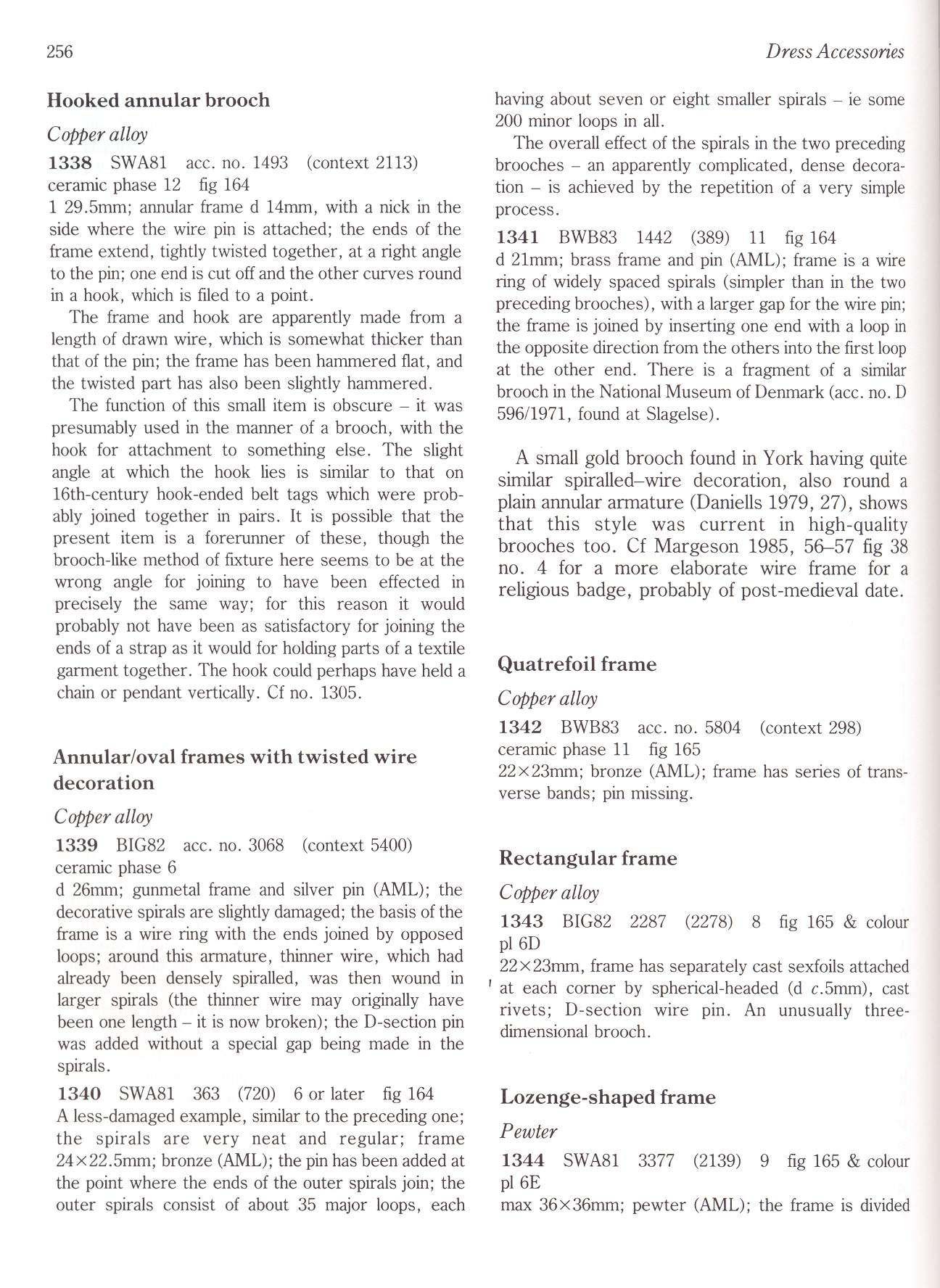284 (41)

256
Dress Accessońes
Hooked annular brooch
Copper alloy
1338 SWA81 acc. no. 1493 (context 2113) ceramic phase 12 fig 164
1 29.5mm; annular frame d 14mm, with a nick in the side where the wire pin is attached; the ends of the frame extend, tightly twisted together, at a right angle to the pin; one end is cut off and the other curves round in a hook, which is filed to a point.
The frame and hook are apparently madę from a length of drawn wire, which is somewhat thicker than that of the pin; the frame has been hammered fiat, and the twisted part has also been slightly hammered.
The function of this smali item is obscure - it was presumably used in the manner of a brooch, with the hook for attachment to something else. The slight angle at which the hook lies is similar to that on 16th-century hook-ended belt tags which were prob-ably joined together in pairs. It is possible that the present item is a forerunner of these, though the brooch-like method of fixture here seems to be at the wrong angle for joining to have been effected in precisely the same way; for this reason it would probably not have been as satisfactory for joining the ends of a strap as it would for holding parts of a textile garment together. The hook could perhaps have held a chain or pendant vertically. Cf no. 1305.
Annular/oval frames with twisted wire decoration
Copper alloy
1339 BIG82 acc. no. 3068 (context 5400) ceramic phase 6
d 26mm; gunmetal frame and silver pin (AML); the decorative spirals are slightly damaged; the basis of the frame is a wire ring with the ends joined by opposed loops; around this armaturę, thinner wire, which had already been densely spiralled, was then wound in larger spirals (the thinner wire may originally have been one length - it is now broken); the D-section pin was added without a special gap being madę in the spirals.
1340 SWA81 363 (720) 6 or later fig 164
A less-damaged example, similar to the preceding one; the spirals are very neat and regular; frame 24x22.5mm; bronze (AML); the pin has been added at the point where the ends of the outer spirals join; the outer spirals consist of about 35 major loops, each
having about seven or eight smaller spirals - ie some 200 minor loops in all.
The overall effect of the spirals in the two preceding brooches - an apparently complicated, dense decoration - is achieved by the repetition of a very simple process.
1341 BWB83 1442 (389) 11 fig 164 d 21mm; brass frame and pin (AML); frame is a wire ring of widely spaced spirals (simpler than in the two preceding brooches), with a larger gap for the wire pin; the frame is joined by inserting one end with a loop in the opposite direction from the others into the first loop at the other end. There is a fragment of a similar brooch in the National Museum of Denmark (acc. no. D 596/1971, found at Slagelse).
A smali gold brooch found in York having quite similar spiralled-wire decoration, also round a plain annular armaturę (Daniells 1979, 27), shows that this style was current in high-quality brooches too. Cf Margeson 1985, 56-57 fig 38 no. 4 for a morę elaborate wire frame for a religious badge, probably of post-medieval datę.
Quatrefoil frame
Copper alloy
1342 BWB83 acc. no. 5804 (context 298) ceramic phase 11 fig 165
22x23mm; bronze (AML); frame has series of trans-verse bands; pin missing.
Rectangular frame
Copper alloy
1343 BIG82 2287 (2278) 8 fig 165 & colour pl 6D
22x23mm, frame has separately cast sexfoils attached ' at each comer by spherical-headed (d c.5mm), cast rivets; D-section wire pin. An unusually three-dimensional brooch.
Lozenge-shaped frame
Pewter
1344 SWA81 3377 (2139) 9 fig 165 & colour pl 6E
max 36x36mm; pewter (AML); the frame is divided
Wyszukiwarka
Podobne podstrony:
343 (24) 316 Dress AccessońesTIN 1584 SWA81 acc. no. 2788 (context 2108) cera
223 (60) 194 Dress AccessońesOCTOFOILS Domed, with holes for separate, single rivets Copper alloy 10
302 (41) 274 Dress Accessońes buttons of the former kind, found in Lund in Sweden). Composite sheeti
270 (41) 242 Dress AccessoriesCOMPARANDA (mounts attached to items other than leather or textile) Ci
266 (41) 238Dress Accessońes 1269 BIG82 acc. no. 2838 (context 3562) ceramic
365 (22) 338Dress Accessońes 1644 BWB83 acc. no. 3508 (context 175) ceramic phases 6-9 fig 221 Top h
399 (12) 372Dress AccessońesConcave ends 1726 CUS73 acc. no. 148 (context 1,12)&nb
286 (34) 258 Dress Accessońes 166 Pentagonal, hexagonal and six-lobed brooches -odginał shapes resto
292 (37) 264 Dress Accessories 1365 171 Yiolet brooches (drawings 1:1, photograph 2:1) (?)flower bud
296 (37) 268 Dress Accessońes Brooches with circular frames Leaf 1374 BC72 2037 (83) 11 fig 174 Poss
298 (39) 270 Dress Accessories Table 5 Brooches - metals used 1 1 Copper i i 2 I I I -1-1—[— 1 1 1
312 (36) 284 Dress Accessories O /v- <& © - O 1428 1406 0 184 Lace chapes (1:1) 1426
274 (42) Dress Accessońes 246 1078 805 1095 (A) mounts with fields of dots (1:1) (
276 (40) 248 Dress Accessońes because no indication has been recognized on them of the wearer’s adhe
277 (39) 249 Brooches 1311 160 Annular brooches (1:1) but in the present instance the lines are much
278 (40) 250 Dress Accessories 1314 1311 SWA81 2186 (2055) 9 fig 160 Corroded
304 (37) 276 Dress Accessońes slightly damaged (an impressed dot here may not be an original feature
306 (35) 180 180 278 Dress Accessońes Cloth buttons and corresponding holes on a sleeve from a depos
308 (39) 280 Dress Accessońes late 13th century onwards. The alloys used in buttons prior to that co
więcej podobnych podstron